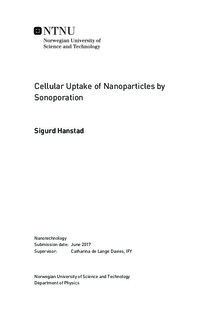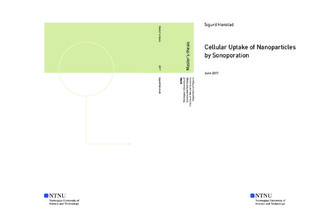| dc.description.abstract | Encapsulation of anti-cancer drugs in nanoparticles (NPs) can solve many of the problems and side-effects related to cancer treatment today. By exposing micrometer-sized gas-filled bubbles to ultrasound, cellular uptake of NPs can be enhanced through a mechanism called sonoporation, or through enhanced endocytosis by affected cells. Much research has been done on sonoporation, but in most cases using small-molecular uptake agents rather than NPs, in combination with lipid microbubbles (MBs).
In this project varying ultrasound parameters were applied to MBs stabilized by a shell of poly(isohexyl cyanoacrylate) (PIHCA) NPs in order to establish their dependency on factors such as mechanical index (MI), pulse repetition frequency (PRF) and cycle length. Additionally, commercially avaialble Sonazoid MBs were used in order to compare the two MBs in terms of their ability to enhance cellular uptake of NPs following ultrasound treatment.
A significantly increased uptake compared to untreated control cells was achieved following ultrasound treatment with NP-stabilized MBs. Cellular uptake was seen in two forms, termed simple and clustered uptake, involving low and very high amount of uptake, respectively. The cellular uptake of PIHCA NPs was found to depend on the pressure applied in that an MI of 0.2 or above was required to increase the uptake compared to the control. Above this MI, the uptake did not seem to increase with increasing MI. It is hypothesized that there exists a threshold below which the biophysical effect of the ultrasound treatment is too small for the NPs to enter the cells. Above this threshold however, the pores created by the sonoporation effect seems to be big enough for most NPs to enter. This threshold is believed to lie between 0.1 and 0.2 MI. Uptake was also seen at 4$\degree$C, indicating that enhanced endocytosis does not play an important role in the uptake of the NPs, and that sonoporation is the main uptake mechanism. Increasing the PRF lead to a significant increase in NPs embedded in cellular membranes. In spite of this, the cellular uptake was not increased, likely due to the composition of the MBs.
The use of commercial Sonazoid MBs lead to significantly lower uptake than when using the NP-stabilized MBs. This suggests that the presence of NPs at the MB shell is important, and that it is mainly the NPs of the shell that are taken up, and not free NPs in the solution. | |

